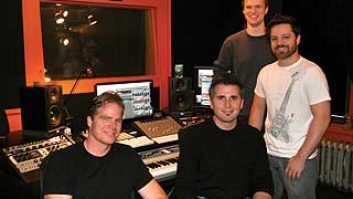The allure of a powerful, portable setup for recording, mixing and even mastering has been the Holy Grail for audio professionals on the go. Finally, like the tumblers of a combination lock falling into place, all the elements needed to attain this goal have arrived.

Of course, the primary component is the laptop. Businesses were the first to forego the desktop in favor of the laptop, as it didn’t take a whole lot of power to run spreadsheets, word processors and hook up to a modem. Audio and video pros, however, were stuck with “desktop replacement” laptops that were heavy, bulky and still lacked the desktop’s power.
Apple��s recent MacBook Pros have in many ways reached parity with desktop systems, especially given the inclusion of the Thunderbolt interface for I/O (see last issue’s Software Tech column). Windows laptops aren’t far behind (and probably won’t be, by the time you read this) but offer the traditional advantages of lower cost and more variety—nothing like Panasonic’s ToughBook exists in Mac-land.
Yet, as anyone who’s tried to go mobile has found out, the laptop is only part of the story. So, let’s consider the other elements that have made mobile computing a no-excuses reality.
Switching power supplies. The days of bulky, heavy adapters and transformers are behind us. Almost all portable gear uses compact switching power supplies that handle 100-240V, 50/60 Hz.
Solid-state memory. Solid-state drives have finally come of age and can provide a decent amount of storage without having to sell your soul. Many laptops offer solid- state disk drives as an option (or even standard), with the advantages of zero noise, no moving parts, durability and ultra-fast project loading. But match up a USB 2.0 multi-Gigbayte memory stick with a USB 2.0 port, and you can record directly to flash memory—even with relatively high track counts (I’ve recorded more than four simultaneous stereo tracks with a moderately fast USB memory stick). Although you can’t stream video to these (yet), for audio, they mean no more carrying an external hard drive for recording, or being forced to record to the same drive that holds your system and programs. Furthermore, starting with Vista, Windows allowed using external memory as an adjunct to internal memory, which boosts overall system performance.
Audio. The onboard audio on computers leaves much to be desired, but a new generation of FireWire and USB interfaces has been designed specifically for mobility. There are three basic types of mobile interfaces. The first places a premium on small size (i.e., the approximate size of a cell phone, or even smaller), and provides high-quality audio monitoring. A good example is CEntrance’s DACPort, which is truly audiophile-quality. But even some other “micro” interfaces, like Avid’s Mbox Micro, M-Audio’s Transit or the ones designed for musicians with relatively simple needs (like interfacing guitar to a laptop-based rig), are an improvement over what you’ll find built into a laptop.
The second kind of mobile interface is somewhat larger, buspowered, and has a limited number of inputs for relatively modest recording requirements—for example, solo artists, songwriters, DJs, rehearsals and the like. The third type has the capabilities of desktop-oriented interfaces, but in a more compact package, and typically require external power. A good example is Roland’s Octa- Capture, which is very compact yet still has eight quality mic pres with individual, switchable phantom power for each one, along with built-in DSP for dynamics and a “learn” function for setting levels to avoid overloads—particularly handy for live performance recording, where you get only one shot.
Headphones. Although it’s not hard to find space for a good set of headphones, I was shocked by the accuracy of Monster’s Turbo Copper earbuds. I took them on a business trip to Europe for casual listening, but unexpectedly, was asked to do a couple videos while I was there. I went ahead with the earbuds and did the rough mixing and processing so the client could give preliminary approval, but when I got home, the mix coming out of my monitors was pretty much the mix I heard in the earbuds. What’s more, Focusrite has come with a DSPbased technology called VRM (Virtual Reference Monitoring) for headphones that emulates listening to a variety of speakers in various acoustic spaces, and is available in a small, portable headphone amp. While I wouldn’t say the experience is exactly the same, it provides the same type of “reality check” advantages that switching among different speakers provides in more traditional studio environments.
With all these improvements in key elements of the mobile recording experience, the world has truly become your studio. Ten years ago, most audio professionals would never have considered doing any kind of serious audio projects with a laptop, but it’s becoming more common all the time.
Craig Anderton is executive editor of Electronic Musician magazine and editor in chief of harmonycentral.com.


